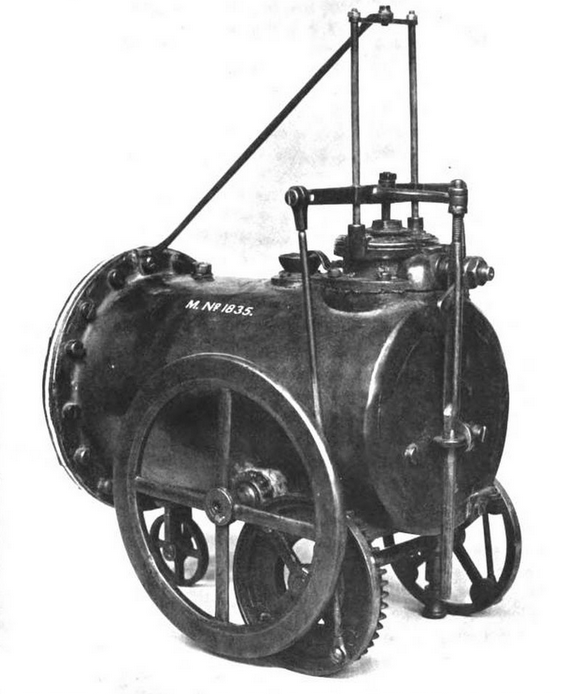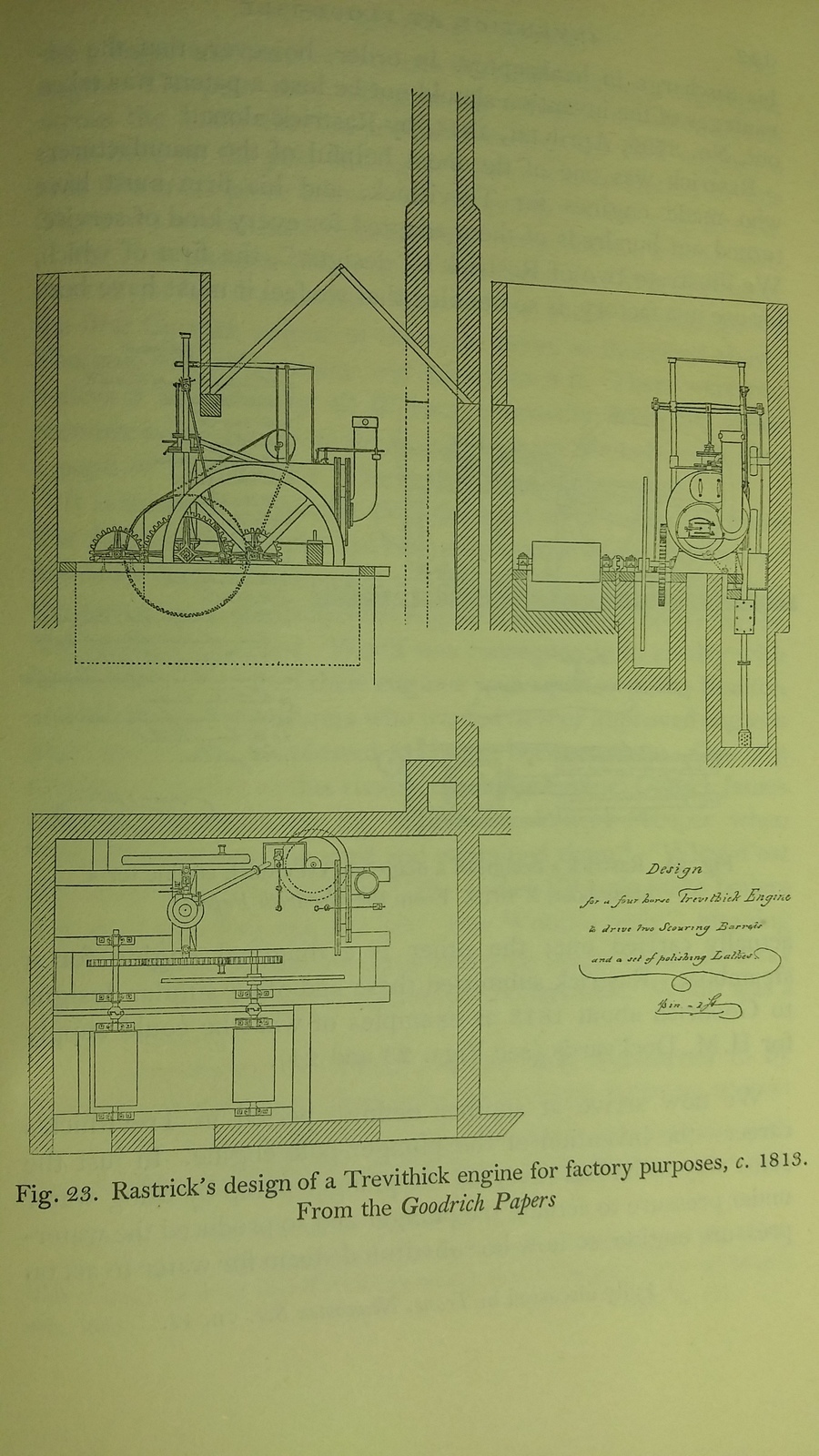Richard Trevithick (1771-1833) was the son of a Cornwall mine-captain. It may be safe to assume that he became familiar with Newcomen’s as well as Watt’s engines in his childhood, because they were used in Cornwall to drain the mines as soon as possible.
Sources
The sources regarding Richard Trevithick are somewhat sparse. Only few letters or sketches from his hand are preserved. A very early biography has been written by one of his sons. John Farey wrote in detail about Trevithick in his second volume of “A Treatise on the Steam Engine”, but this book has never been published as long as Farey lived. The text has been discovered, but the plates are missing. Today we have quite a few books on Trevithick which emphasize his role in the early development of the steam engine, but fact focussed works or scientific papers on his part in the history of technology are rare. In 1934 Dickinson and Arthur Titley published “Richard Trevithick. The Engineer and the Man”. This was meant to commemorate Trevithick’s 100th day of death. From my point of view this book is still the most reliable source . Younger books often refer to this work.
Whim Puffer
1797 was a very important year for Richard Trevithick. After his father died in August 1797 Richard was appointed as “Mine Captain”. He now had an income and could start a family. In November 1797 Richard married a doughter of John Harvey, who had established the foundry of Harvey & Co in Hayle.
The oldest source regarding “Puffer” is in a letter of Davies Gilbert (originally Giddy) from 1839. Gilbert had been President of the Royal Society for some years. How this exceptional friendship between the roughneck from Cornwall Trevithick and the Priest’s son Gilbert evolved is not known. In his letter Gilbert writes, that Trevithick asked him, how much power would be lost if one would omit condensing the steam 1:
would be the loss of power in working an Engine by the force of Steam raised to the Pressure of several Atmospheres, but instead of condensing to let the steam escape. I, of course, answered at once that the loss of power would be one Atmosphere, diminished power by the saving of an air Pump with its Friction and in many cases with the saving of condensing water. I never saw a Man more delighted, and I believe that within a Month several “Puffers” were in actual work.
In the biography Francis Trevithick wrote about his father several models built by his father’s brother-in-law William West are mentionend. According to Dickinson there is a model in the collection of the Science Museum London, which can be traced back to the year 1810. Dickinson und Titley assume that it is an original (Picture 1 2):

This model fits nicely to the one, Tom Walshaw has developed (apart from that the model is movable). In the introduction of his building description Walshaw states, that the Science Museum even owns a real Trevithick Puffer. In 1882 F.W. Webb (long time technical director of the London and North Western Railway) found remainings of a puffer in a scrapyard. Webb bought it and cared for restoration in “his” lokomotive works at Crewe. According to Walshaw crankshaft, main bearings, connecting rods and chimney were missing, as well as, perhaps, feedpump and boiler supports. He could measure up the engine in the Science Museum and used this data in designing the model 3.
Unfortunately I could not find a picture of this engine on the Science Museum’s website. Thanks to the Gutenberg Project here is an etching from 1885 (which Walshaw too reproduced in this introduction) (Picture 2 4):

The name “Whim Puffer” is really to the point. In Cornwall Whim is the device to get into a mine’s shaft with. In the simplest case this may have been a barrel with a rope. Puffer refers to the working noise of the engine. Because the steam was not condensed, the “puff” when steam escaped could be heared clearly.
Trevithick did not build his engines by himself, he just provided the ideas. Only a few very rough sketches from his hand are preserved. Casts were supplied by his father-on-law Harvey of Hayle, William West among others built the actual engines.
The number of “whim puffers” built is given by Dickinson as “close upon fifty engines”5. He refers to a letter from Trevithick to Gilbert from 1804. Various purposes such as driving sugar mills, grinding corn, pumping water, winding coal and rolling iron are listed.
In Fig. 23 Dickinson + Titley have a picture, which is only rarely shown (Picture 3 6). This is a sketch for a Whim Puffer used to drive two scouring barrels and polishing lathes:

The inscript reads:
Design for a four horse Trevithick Engine to drive two Scouring Barrels and a set of polishing Lathes
The author John Urpeth Rastrick was engineer at John Hazledine. The big scouring barrels with jaw clutches can be seens on the flywheel side. On the other side of the boiler a big wheel with a belt drives the transmissions for the polishing lathes.
Dredger Engine
The “Whim Puffer” was not only a pumping, but a real power engine, which could be used for quite different tasks. It
- was relatively small and lightweight
- did not have any preconditions to an engine house
- could be transfered to another place without too much hassle
- was not too expensive.
Trevithick, who went to London after some projects, which did not turn out really successful, tried to participate in building the West India Docks (these were the first harbour facilities for merchant shipping in London). He proposed to install Whim Puffers on three barges and to use them as power source for dredgers. This happened, but it is unclear, how successful the steam powered dredging was in the end. The engines may have been not a major problem, but the dredging machinery was still in a very infantine state.
A drawing of these dredging device was published 1819 in Rees’s Cyclopaedia.
Miscellaneous
The Whim Puffer of the Science Museum London is the only one I am aware of. There are replicas of Trevithick’s more spectacular works like the road carriage, the locomotive or his steam carriage. You may see these in motion quite nice here:
YouTube: Mark Williams on the Rails 01 Cornish Steam Giant
Version: 21.12.2016
-
Dickinson + Titley, 1934, Plate VI Online at http://www.gracesguide.co.uk/File:Im1934RTrev-Roadloco.jpg, per 23.12.2016 ↩
-
T.D. Walshaw alias Tubal Cain, Model Engineer 3809, 1987, S. 310 ff. ↩
-
Scientific American Supplement, Vol. XIX, No. 470, Jan. 3, 1885 per 23.12.2016 ↩
-
Dickinson + Titley, 1934, Fig. 23 Online at http://www.gracesguide.co.uk/File:Im1934RTrev-Rastrick.jpg, per 23.12.2016 ↩